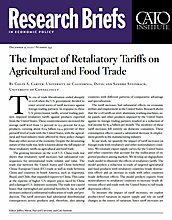The tariff increases had substantial effects on economic welfare and employment in the United States. Research shows that the 2018 tariffs on steel, aluminum, washing machines, solar panels, and other products imposed by the United States against its foreign trading partners resulted in a reduction of real income by $1.4 billion per month. The incidence of these tariff increases fell entirely on domestic consumers. These consumption effects caused a substantial decrease in employment growth in the manufacturing industry.
In our work, we quantify the impact of tariff increases on foreign trade with retaliatory and other nonretaliatory countries. We estimate export supply curves for the United States and other countries that account for the reallocation of exported products among markets. We develop an oligopolistic trade model to illustrate the effects of retaliatory tariffs. The model predicts a reduction in trade of targeted agricultural and food products with retaliatory countries (trade destruction effect) and an increase in trade with other countries (trade deflection effect). The model predicts exports from nonretaliatory to retaliatory countries to increase (trade diversion effect) and trade with the United States to fall (trade depression effect).
To measure the impact of tariff increases, we exploit product-level variation in export supply and rely on tariff changes as the source of variation. Since tariff increases are uncorrelated with demand and supply shocks, we can use them to instrument for the foreign export supply curves. This approach allows us to measure the partial redistribution effects of retaliatory tariffs.
Our results indicate large and statistically significant trade effects of retaliatory tariff increases for the United States and nonretaliatory countries. We find that the United States lost more than $15.6 billion in trade with retaliatory countries. Soybeans, pork products, and coarse grains recorded the most substantial trade destruction effects. These losses were only partially offset by additional exports to nonretaliatory countries. At the same time, nonretaliatory countries were able to considerably expand their exports to retaliatory countries. The analysis shows that these countries gained $13.5 billion in additional trade with retaliatory countries.
The trade diversion effects are dominated by increasing exports of soybeans and pork products. The primary beneficiaries of retaliatory tariff increases were countries from South America, such as Argentina, Brazil, and Chile. Retaliatory countries also increased their imports from eastern Europe and the EU. These results indicate that the 2018 trade war had substantial redistribution effects for global agricultural and food trade.
NOTE:
This research brief is based on Colin A. Carter and Sandro
Steinbach, “The Impact of Retaliatory Tariffs on Agricultural and
Food Trade,” NBER Working Paper no. 27147, May 2020, https://doi.org/10.3386/w27147.

